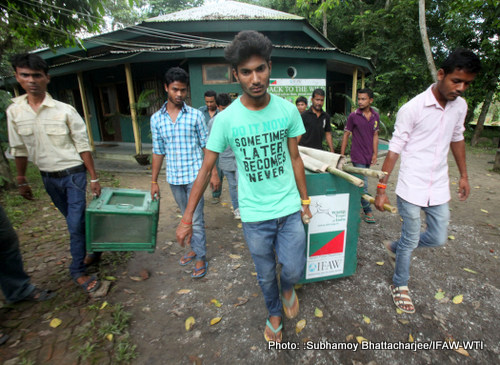
Volunteers conducting a mock drill at CWRC
CWRC, Kaziranga, June 19, 2015: The ongoing pre-flood awareness campaign in Kaziranga–Karbi Anglong landscape with support from Elephant Family and Kaziranga Forest Authority saw the youth from the corridor villages being trained on wildlife rescue by the experts from Centre for Wildlife Rehabilitation and Conservation (CWRC)– the IFAW-WTI animal care facility.
Nine individuals who participated in this unique exercise are from the Western Range of Kaziranga National Park that is connected with Karbi Anglong, where animals tend to move, seeking higher ground during the annual floods.
Wildlife Trust of India in a joint venture with Elephant Family is trying to develop a volunteer group for ‘Corridor Monitoring’ during floods with help from local youth. This Corridor Monitoring process will help this group to know the status of displaced animals and provide adequate protection to animals in distress.
Dilip Deori, Manager and Project Lead, Karbi Anglong Conservation Project, said, “This group of nine are being trained by the experts to study the animal movement and behaviour in different seasons, especially during floods. The corridors where these volunteers would be active are Kanchajuri, Amguri and Panbari. These volunteers would be called Green Corridor Monitors (GCM) and will keep an eye on animal movement, especially elephants. The changing patterns of animal habitat will also be a part of this study.”
These GCMs in corridors are also the residents of these areas making it easier for them to collect information and share the same with WTI staff in case of any wildlife emergencies. Dr. Biswajit Boruah of CWRC, said, “These trainings are the need of the hour in Kaziranga National Park and will help in preventing people from conducting unnecessary rescues causing displacement of animals in their bid to save the animals during floods.”
The youth were given hands-on training with a mock drill of animal rescue in the CWRC campus by Dr. Panjit Basumatary and animal keepers of the centre. The volunteers had a class room session with an audio-visual presentation followed by a mock exercise on rescue of herbivores and carnivores along with reptiles as part of the training.